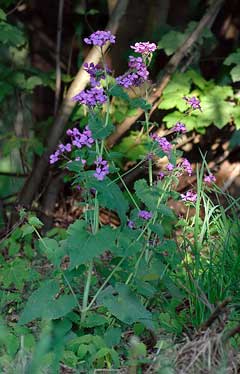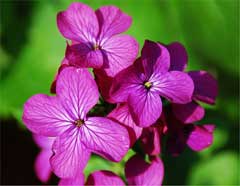 |
|
http://commons.wikimedia.org/wiki/User:Aka |
 |
| http://commons.wikimedia.org/wiki/User:Ericoides |
Translate this page:
Summary
Bloom Color: Pink, Purple. Main Bloom Time: Late spring, Mid spring. Form: Upright or erect.
Physical Characteristics

 Lunaria annua is a ANNUAL/BIENNIAL growing to 0.6 m (2ft) by 0.3 m (1ft in) at a fast rate.
Lunaria annua is a ANNUAL/BIENNIAL growing to 0.6 m (2ft) by 0.3 m (1ft in) at a fast rate.
See above for USDA hardiness. It is hardy to UK zone 6 and is not frost tender. It is in flower from May to July, and the seeds ripen from June to August. The species is hermaphrodite (has both male and female organs) and is pollinated by Bees, flies, Lepidoptera (Moths & Butterflies). The plant is self-fertile.
It is noted for attracting wildlife.
Suitable for: light (sandy), medium (loamy) and heavy (clay) soils. Suitable pH: mildly acid, neutral and basic (mildly alkaline) soils. It can grow in semi-shade (light woodland) or no shade. It prefers moist soil and can tolerate drought.
UK Hardiness Map
US Hardiness Map
Synonyms
L. biennis.
Plant Habitats
Cultivated Beds;
Edible Uses
Edible Parts: Root Seed
Edible Uses: Condiment
Seed - cooked. A pungent flavour, they are used as a mustard substitute[183]. The pungency of mustard develops when cold water is added to the ground-up seed - an enzyme (myrosin) acts on a glycoside (sinigrin) to produce a sulphur compound. The reaction takes 10 - 15 minutes. Mixing with hot water or vinegar, or adding salt, inhibits the enzyme and produces a mild bitter mustard[238]. Root - raw[2, 61, 177]. Used before the plant produces flowers[46, 183].
References More on Edible Uses
Medicinal Uses
Plants For A Future can not take any responsibility for any adverse effects from the use of plants. Always seek advice from a professional before using a plant medicinally.
None known
References More on Medicinal Uses
The Bookshop: Edible Plant Books
Our Latest books on Perennial Plants For Food Forests and Permaculture Gardens in paperback or digital formats.

Edible Tropical Plants
Food Forest Plants for Hotter Conditions: 250+ Plants For Tropical Food Forests & Permaculture Gardens.
More

Edible Temperate Plants
Plants for Your Food Forest: 500 Plants for Temperate Food Forests & Permaculture Gardens.
More

More Books
PFAF have eight books available in paperback and digital formats. Browse the shop for more information.
Shop Now
Other Uses
References More on Other Uses
Cultivation details
Landscape Uses:Border, Container, Massing, Woodland garden. Succeeds in ordinary garden soil[1]. Prefers a light soil[108]. Prefers partial shade but also succeeds in full sun[188]. Established plants tolerate drought[190]. Plants are hardy to about -15°c[200]. A good bee and butterfly plant[30]. Often grown in the flower garden[1], it is occasionally cultivated for its root[61]. Plants are fast-growing and usually self-sow freely[188]. Special Features:Not North American native, Naturalizing, Attracts butterflies, Suitable for cut flowers, Suitable for dried flowers, Fragrant flowers.
References Carbon Farming Information and Carbon Sequestration Information
Temperature Converter
Type a value in the Celsius field to convert the value to Fahrenheit:
Fahrenheit:
The PFAF Bookshop
Plants For A Future have a number of books available in paperback and digital form. Book titles include Edible Plants, Edible Perennials, Edible Trees,Edible Shrubs, Woodland Gardening, and Temperate Food Forest Plants. Our new book is Food Forest Plants For Hotter Conditions (Tropical and Sub-Tropical).
Shop Now
Plant Propagation
Seed - sow early spring or early autumn in situ[200]. The plant will often self-sow.
Other Names
If available other names are mentioned here
Native Range
EUROPE: Albania, Bulgaria, Bosnia and Herzegovina, Greece (incl. Crete), Croatia, Italy, North Macedonia, Montenegro, Romania (southwest), Serbia
Weed Potential
Right plant wrong place. We are currently updating this section.
Please note that a plant may be invasive in one area but may not in your area so it's worth checking.
Conservation Status
IUCN Red List of Threatened Plants Status :

Growth: S = slow M = medium F = fast. Soil: L = light (sandy) M = medium H = heavy (clay). pH: A = acid N = neutral B = basic (alkaline). Shade: F = full shade S = semi-shade N = no shade. Moisture: D = dry M = Moist We = wet Wa = water.
Now available:
Food Forest Plants for Mediterranean Conditions
350+ Perennial Plants For Mediterranean and Drier Food Forests and Permaculture Gardens.
[Paperback and eBook]
This is the third in Plants For A Future's series of plant guides for food forests tailored to
specific climate zones. Following volumes on temperate and tropical ecosystems, this book focuses
on species suited to Mediterranean conditions—regions with hot, dry summers and cool, wet winters,
often facing the added challenge of climate change.
Read More
Expert comment
Author
L.
Botanical References
17200
Links / References
For a list of references used on this page please go here
Readers comment